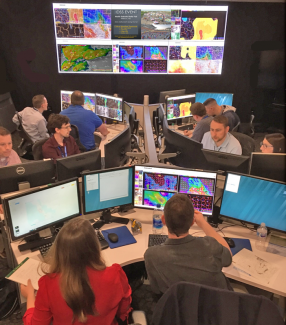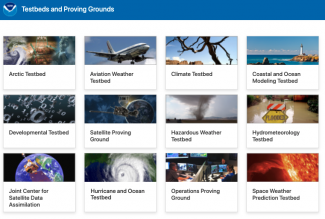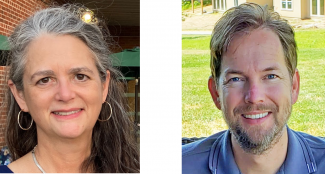The Test Bed and Proving Ground Coordination Committee (TBPGCC, www.testbeds.noaa.gov) is composed of representatives from the 12 NOAA Testbeds (TBs) and Proving Grounds (PGs), including a member from the DTC.
Collectively and individually, they facilitate the orderly transition of research capabilities to operational implementation and other applications, often called R2X, and thus, are crucial for transitioning research into operations at NOAA and other partners, and ultimately into societal benefits. The TBPGCC strives to build collaborations and synergies among TBs, and PGs where appropriate, to ameliorate the realities of organizational and funding stovepipes, and take advantage of common opportunities. The TBPG holds an annual workshop and monthly meetings to carry out these endeavors. Just as DTC is a distributed facility where the NWP community can test and evaluate new models and techniques for use in research and operations, TBPGs are working relationships for developmental testing, in a quasi-operational framework among researchers and operational scientists/experts (measurement specialists, forecasters, IT specialists, etc.). Typically, this includes partners in academia, the private sector, and government agencies, whose activities aim to improve or enhance operations in the context of user needs. TBPG activities are two-way interactions with both R2O and O2R, and are iterative whereby any particular project is generally tested multiple ways, and often more than one TBPG involved. Metrics for evaluation and acceptance for operational use vary among testbeds and proving grounds, but generally include evaluation of the research product. First, the tool, method, or analysis is evaluated for how it impacts the resulting skill or quality of resulting products or services. Second is an evaluation of whether it is efficient and effective both in terms of the forecasters’ process to create products, and use by customers. Third, it is evaluated for compatibility with operational hardware, software, data, and communication.
The network has been engaging in new ways to collaborate over the past several years. Beginning in 2019, the annual meeting changed format from primarily science sharing talks from each TBPG to focusing more on project updates, to a format with sessions framed as learning exchanges about successes, challenges and lessons learned. Sessions also focused on the role and challenges of testbeds for external efforts such as the Unified Forecast System (UFS), artificial intelligence (AI), and cloud computing. This format change improved our collaborative efforts and fostered more open and honest discussion between TBPGs. The 2021 meeting also included the first ever session on social and behavioral sciences, as well as a session about working in the virtual environment. Several testbeds have included some virtual aspects in the past, but the pandemic forced all experiments to go completely virtual. While the virtual environment has had benefits, such as allowing people to participate who might not be able to travel or to leave their positions for a week, it has also had challenges. Inherently face-to-face interactions, including experiments - especially ones that involved using and sharing equipment and facilities - have been seriously hampered. The meeting included sessions focusing on coordination of other TBPGs with the Operations PG, the Satellite PG, and the emerging Fire Weather TB, and on funding issues as well. The push of research funding currently exceeds the capacity of TB/PGs to evaluate efforts. Furthermore, while TBPGs are excited about the advent of UFS and opportunities to use Cloud and AI, generally flat funding limits the potential to take advantage of these for R2X, especially during the transition period from the current NCEP production suite to the Unified Forecast System (UFS).
The TBPGCC plans to expand efforts to coordinate planning in the upcoming year, and look for collaboration opportunities in the next two to three years, and will expand its efforts to speak as a group on topics such as UFS development.


